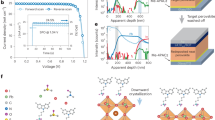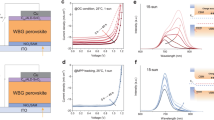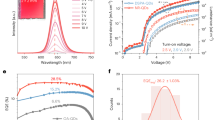Abstract
Following pioneering work1, solution-processable organic–inorganic hybrid perovskites—such as CH3NH3PbX3 (X = Cl, Br, I)—have attracted attention as light-harvesting materials for mesoscopic solar cells2,3,4,5,6,7,8,9,10,11,12,13,14,15. So far, the perovskite pigment has been deposited in a single step onto mesoporous metal oxide films using a mixture of PbX2 and CH3NH3X in a common solvent. However, the uncontrolled precipitation of the perovskite produces large morphological variations, resulting in a wide spread of photovoltaic performance in the resulting devices, which hampers the prospects for practical applications. Here we describe a sequential deposition method for the formation of the perovskite pigment within the porous metal oxide film. PbI2 is first introduced from solution into a nanoporous titanium dioxide film and subsequently transformed into the perovskite by exposing it to a solution of CH3NH3I. We find that the conversion occurs within the nanoporous host as soon as the two components come into contact, permitting much better control over the perovskite morphology than is possible with the previously employed route. Using this technique for the fabrication of solid-state mesoscopic solar cells greatly increases the reproducibility of their performance and allows us to achieve a power conversion efficiency of approximately 15 per cent (measured under standard AM1.5G test conditions on solar zenith angle, solar light intensity and cell temperature). This two-step method should provide new opportunities for the fabrication of solution-processed photovoltaic cells with unprecedented power conversion efficiencies and high stability equal to or even greater than those of today’s best thin-film photovoltaic devices.
This is a preview of subscription content, access via your institution
Access options
Subscribe to this journal
Receive 51 print issues and online access
$199.00 per year
only $3.90 per issue
Buy this article
- Purchase on SpringerLink
- Instant access to full article PDF
Prices may be subject to local taxes which are calculated during checkout



Similar content being viewed by others
References
Kojima, A., Teshima, K., Shirai, Y. & Miyasaka, T. Organometal halide perovskites as visible-light sensitizers for photovoltaic cells. J. Am. Chem. Soc. 131, 6050–6051 (2009)
Hagfeldt, A., Boschloo, G., Sun, L., Kloo, L. & Pettersson, H. Dye-sensitized solar cells. Chem. Rev. 110, 6595–6663 (2010)
Im, J.-H. et al. 6.5% efficient perovskite quantum-dot-sensitized solar cell. Nanoscale 3, 4088–4093 (2011)
Kim, H.-S. et al. Lead iodide perovskite sensitized all-solid-state submicron thin film mesoscopic solar cell with efficiency exceeding 9%. Sci. Rep. 2, 591 (2012)
Lee, M. M., Teuscher, J., Miyasaka, T., Murakami, T. N. & Snaith, H. J. Efficient hybrid solar cells based on meso-superstructured organometal halide perovskites. Science 338, 643–647 (2012)
Etgar, L. et al. Mesoscopic CH3NH3PbI3/TiO2 heterojunction solar cells. J. Am. Chem. Soc. 134, 17396–17399 (2012)
Im, J.-H., Chung, J., Kim, S.-J. & Park, N.-G. Synthesis, structure, and photovoltaic property of a nanocrystalline 2H perovskite-type novel sensitizer (CH3CH2NH3)PbI3 . Nanoscale Res. Lett. 7, 353 (2012)
Edri, E., Kirmayer, S., Cahen, D. & Hodes, G. High open-circuit voltage solar cells based on organic-inorganic lead bromide perovskite. Phys. Chem. Lett. 4, 897–902 (2013)
Crossland, E. J. W. et al. Mesoporous TiO2 single crystals delivering enhanced mobility and optoelectronic device performance. Nature 495, 215–219 (2013)
Noh, J. H., Im, S. H., Heo, J. H., Mandal, T. N. & Seok, S. I. Chemical management for colorful, efficient, and stable inorganic−organic hybrid nanostructured solar cells. Nano Lett. 13, 1764–1769 (2013)
Cai, B., Xing, Y., Yang, Z., Zhang, W.-H. & Qiu, J. High performance hybrid solar cells sensitized by organolead halide perovskites. Energy Environ. Sci. 6, 1480–1485 (2013)
Qui, J. et al. All-solid-state hybrid solar cells based on a new organometal halide perovskite sensitizer and one-dimensional TiO2 nanowire arrays. Nanoscale 5, 3245–3248 (2013)
Ball, J. M., Lee, M. M., Hey, A. & Snaith, H. J. Low-temperature processed meso-superstructured to thin-film perovskite solar cells. Energy Environ. Sci. 6, 1739–1743 (2013)
Bi, D., Yang, L., Boschloo, G., Hagfeldt, A. & Johansson, E. M. J. Effect of different hole transport materials on recombination in CH3NH3PbI3 perovskite-sensitized mesoscopic solar cells. J. Phys. Chem. Lett. 4, 1532–1536 (2013)
Heo, J. H. et al. Efficient inorganic–organic hybrid heterojunction solar cells containing perovskite compound and polymeric hole conductors. Nature Photon. 7, 486–492 (2013)
Beckmann, A. A review of polytypism in lead iodide. Cryst. Res. Technol. 45, 455–460 (2010)
Baikie, T. et al. Synthesis and crystal chemistry of the hybrid perovskite (CH3NH3)PbI3 for solid-state sensitized solar cell applications. J. Mater. Chem. A 1, 5628–5641 (2013)
Liang, K., Mitzi, D. B. & Prikas, M. T. Synthesis and characterization of organic-inorganic perovskite thin films prepared using a versatile two-step dipping technique. Chem. Mater. 10, 403–411 (1998)
Beberwyck, B. J. & Alivisatos, A. P. Ion exchange synthesis of III–V nanocrystals. J. Am. Chem. Soc. 134, 19977–19980 (2012)
Luther, J. M., Zheng, H., Sadtler, B. & Alivisatos, A. P. Synthesis of PbS nanorods and other ionic nanocrystals of complex morphology by sequential cation exchange reactions. J. Am. Chem. Soc. 131, 16851–16857 (2009)
Li, H. et al. Sequential cation exchange in nanocrystals: preservation of crystal phase and formation of metastable phases. Nano Lett. 11, 4964–4970 (2011)
Gurina, G. I. & Savchenko, K. V. Intercalation and formation of complexes in the system of lead(II) iodide–ammonia. J. Solid State Chem. 177, 909–915 (2004)
Preda, N., Mihut, L., Baibarac, M., Baltog, I. & Lefrant, S. A distinctive signature in the Raman and photoluminescence spectra of intercalated PbI2 . J. Phys. Condens. Matter 18, 8899–8912 (2006)
Warren, R. F. & Liang, W. Y. Raman spectroscopy of new lead iodide intercalation compounds. J. Phys. Condens. Matter 5, 6407–6418 (1993)
Burschka, J. et al. Tris(2-(1H-pyrazol-1-yl)pyridine)cobalt(III) as p-type dopant for organic semiconductors and its application in highly efficient solid-state dye-sensitized solar cells. J. Am. Chem. Soc. 133, 18042–18045 (2011)
Acknowledgements
We thank M. Marszalek for recording SEM images, M. Tschumi for help with the stability measurements and K. Schenk for the XRD characterization. We acknowledge financial support from Aisin Cosmos R&D Co., Ltd, Japan; the European Community’s Seventh Framework Programme (FP7/2007-2013) ENERGY.2012.10.2.1; NANOMATCELL, grant agreement no. 308997; the Global Research Laboratory Program, Korea; the Center for Advanced Molecular Photovoltaics (award no. KUS-C1-015-21) of King Abdullah University of Science and Technology; and Solvay S.A. M.K.N. thanks the World Class University programmes (Photovoltaic Materials, Department of Material Chemistry, Korea University), funded by the Ministry of Education, Science and Technology through the National Research Foundation of Korea (R31-2008-000-10035-0). M.G. thanks the Max Planck Society for a Max Planck Fellowship at the MPI for Solid State Research in Stuttgart, Germany; the King Abdulaziz University, Jeddah and the Nanyang Technolocal University, Singapore for Adjunct Professor appointments; and the European Research Council for an Advanced Research Grant (ARG 247404) funded under the “Mesolight” project.
Author information
Authors and Affiliations
Contributions
J.B. developed the basic concept, carried out the spectroscopic characterization, fabricated and characterized photovoltaic devices, and coordinated the project. N.P. fabricated and characterized photovoltaic devices, optimized device performance and fabricated high-performance devices for the certification. S.-J.M. contributed to the fabrication and characterization of photovoltaic devices. R.H.-B. contributed to the spectroscopic characterization and data analysis. P.G. synthesized CH3NH3I. M.G. and J.B. analysed the data and wrote the paper. M.K.N. contributed to the supervision of the project. M.G. had the idea for, and directed, the project. All authors reviewed the paper.
Corresponding author
Ethics declarations
Competing interests
The authors declare no competing financial interests.
Supplementary information
Supplementary Information
This file contains Supplementary Figures 1-5 and Supplementary Table 1. (PDF 6620 kb)
Rights and permissions
About this article
Cite this article
Burschka, J., Pellet, N., Moon, SJ. et al. Sequential deposition as a route to high-performance perovskite-sensitized solar cells. Nature 499, 316–319 (2013). https://doi.org/10.1038/nature12340
Received:
Accepted:
Published:
Issue Date:
DOI: https://doi.org/10.1038/nature12340
This article is cited by
-
Mixed tin-lead perovskites with balanced crystallization and oxidation barrier for all-perovskite tandem solar cells
Nature Communications (2024)
-
Efficient and stable perovskite solar cells with regulated depletion region
Nature Photonics (2024)
-
Ultrafast photo-induced carrier dynamics of perovskite films being degraded by atmospheric exposure
Journal of the Korean Physical Society (2024)
-
Perovskite/silicon tandem solar cells–compositions for improved stability and power conversion efficiency
Photochemical & Photobiological Sciences (2024)
-
Lead-free alternative cation (Ethylammonium) in organometallic perovskites for thermoelectric applications
Journal of Molecular Modeling (2024)



